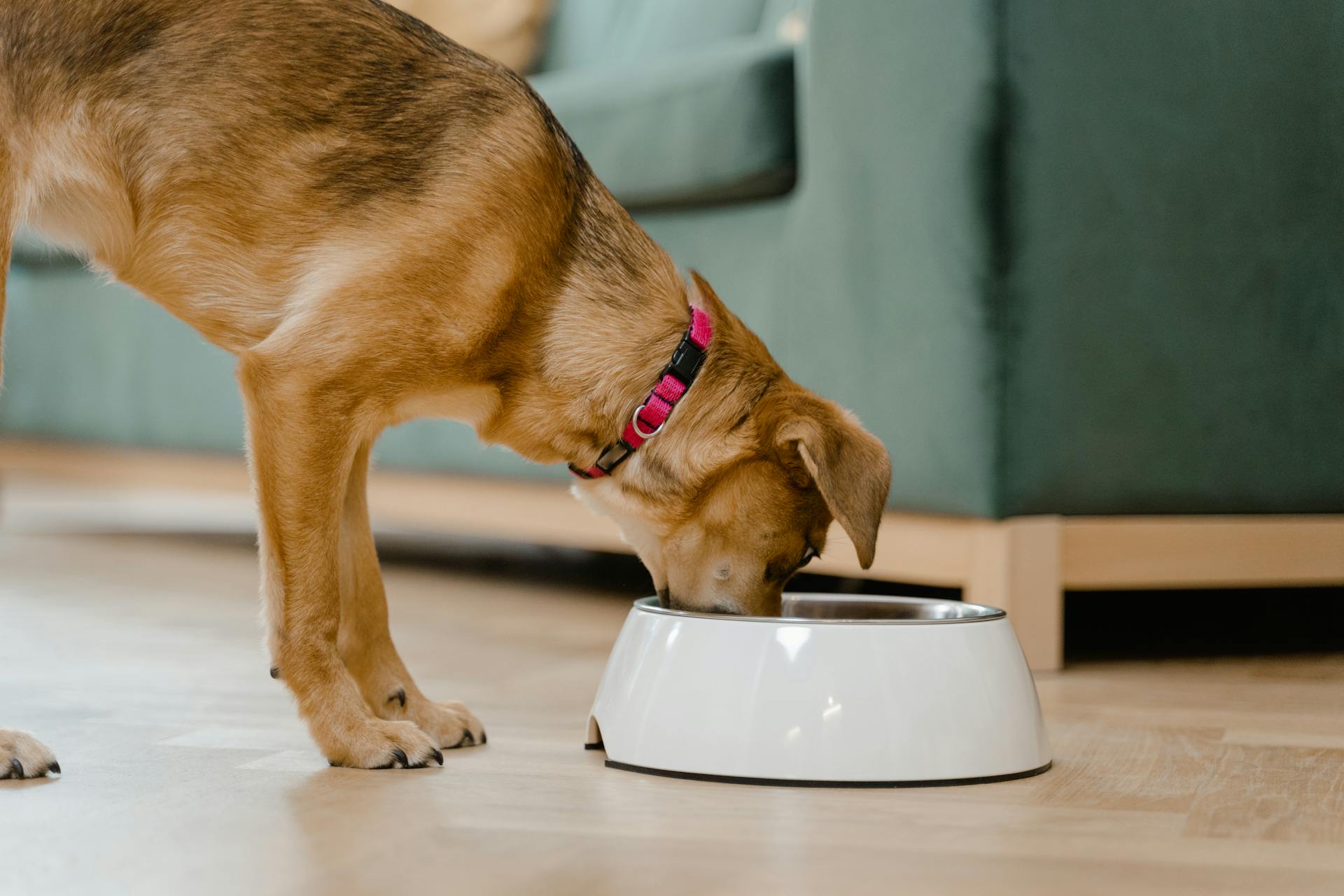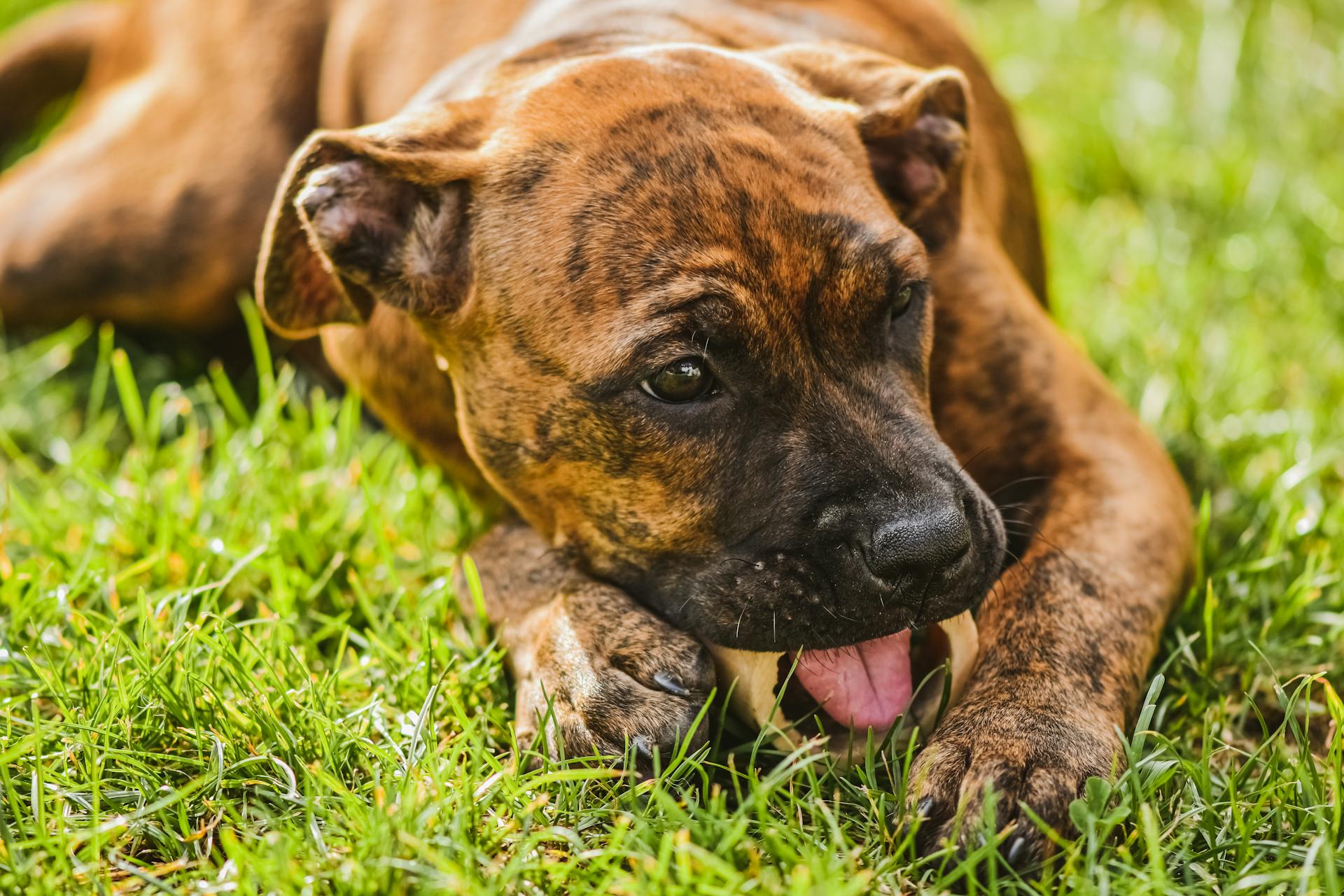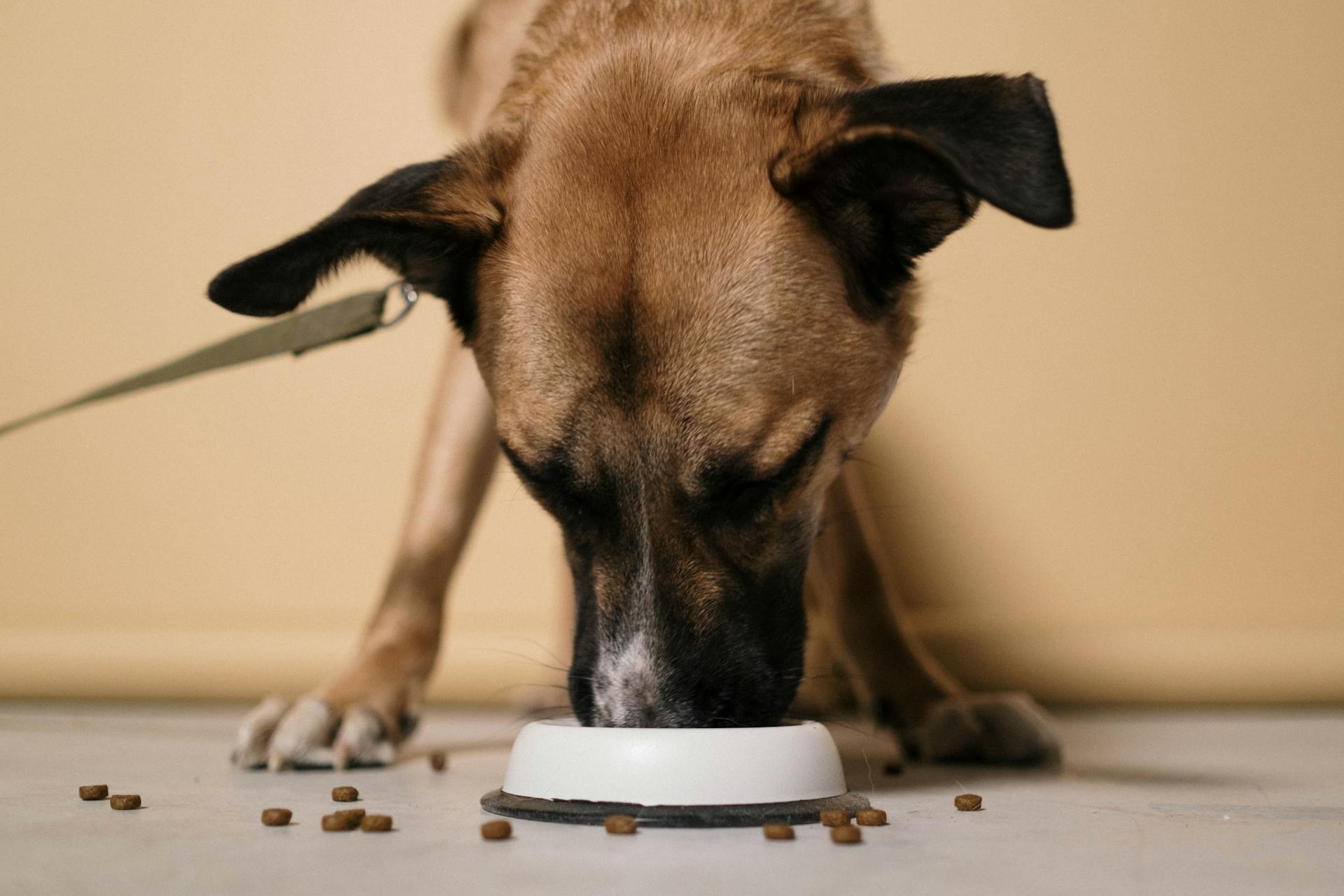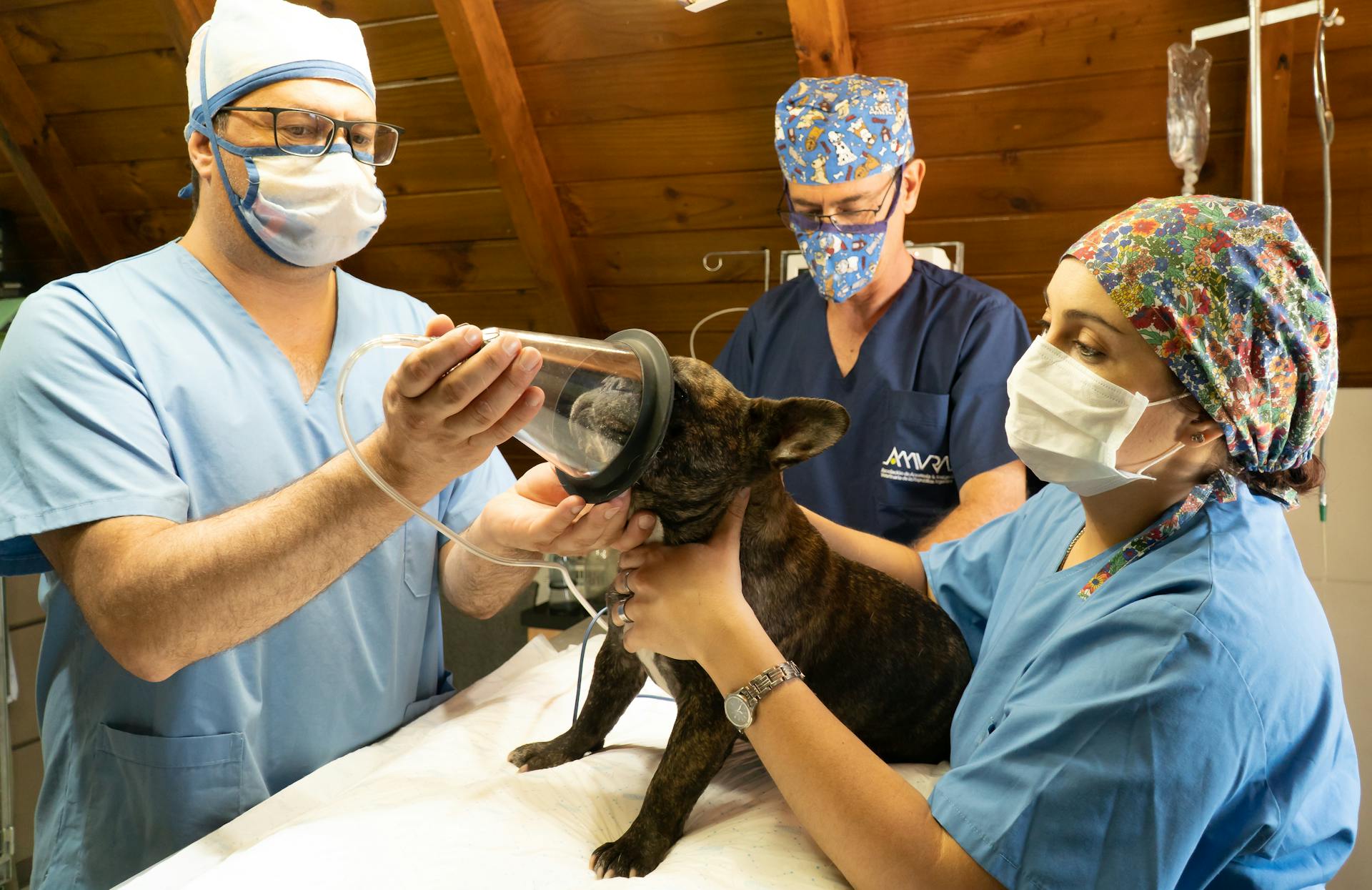
Bloat is a life-threatening condition that can occur in dogs, especially those with deep chests or eating habits that lead to rapid eating.
Gastric dilatation-volvulus, or GDV, is the medical term for bloat, and it can happen in as little as 30 minutes.
Dogs that are prone to bloat are often breeds like Great Danes, German Shepherds, and Labradors.
Eating too quickly can lead to bloat, so it's essential to slow down mealtime.
Foods high in fat, such as table scraps, can also contribute to bloat.
Dogs that eat a large meal and then exercise heavily may be more likely to experience bloat.
A dog's age can also play a role in bloat risk, with older dogs being more susceptible.
Curious to learn more? Check out: Do All Dog Bites Lead to Rabies
Causes and Risk Factors
Bloat can occur at any age, but it's most common in middle-aged dogs. Research shows that the risk increases 20% per year of age.
Large breed dogs with deep chests, such as Great Danes, are more likely to bloat. In fact, Great Danes are 5 to 8 times more likely to bloat than dogs with a low height to width ratio.
Eating quickly, overeating, and drinking a lot of water at once can contribute to bloat. This is because it can cause the stomach to twist and cut off blood flow.
Stressful situations, such as boarding kennels, can also increase a dog's risk of bloat. Anxious dogs are thought to be more prone to bloat, too.
Here are some common risk factors for bloat:
- Eating very quickly
- Overeating
- Drinking a large quantity of water in a short period of time
- Raised food bowls
- Stress (anxious dogs are thought to be more prone)
- Exercising after eating
- Increased age
Male dogs are twice as likely to develop bloat as females, and dogs over seven years old are more than twice as likely to develop bloat than those who are two to four years old.
Symptoms and Diagnosis
Bloat can be a silent killer in dogs, and recognizing the symptoms is crucial to increasing their chances of survival. Bloat, also known as Gastric Dilatation and Volvulus Syndrome, can develop without warning and progress very quickly.
The symptoms of bloat often have a rapid onset, and dogs can deteriorate quickly. Non-productive retching, excessive salivation, restlessness, and abdominal distension are some of the common signs of bloat. A swollen or distended abdomen, painful abdomen, and overall look of distress are also early signs of bloat.
If left untreated, bloat can lead to shock, which can be fatal within an hour or two. The heart rate will rise, and the pulse will get weaker, leading to death. In this critical situation, prompt veterinary attention is essential.
For your interest: Signs Your Dog Doesn T Have Bloat
Signs and Symptoms of Twisted Stomach
Bloat, also known as Gastric Dilatation and Volvulus (GDV), is a serious condition that can be fatal if left untreated. The symptoms can be subtle at first but quickly progress, making it essential to recognize the signs early on.
A swollen or distended abdomen is a common sign of bloat, and it can be so severe that it makes it difficult for the dog to stand comfortably. Excessive salivation is another symptom, often accompanied by restlessness and attempts to vomit with no success.
If you press on your dog's belly, they may show signs of pain and whine. This is a clear indication that something is wrong. The abdomen may also make a 'ping' sound when tapped, which is a distinctive sign of bloat.
Here are some common symptoms of bloat:
- Abdominal distention (swollen stomach)
- Non-productive vomiting (appears to be vomiting, but nothing comes up or only produces white froth)
- Retching
- Lethargy
- Agitation
- Discomfort
- Abdominal pain
- Difficulty breathing
- Excessive salivation
- Weak pulse
- Rapid heart rate
- Pale gums
- Shock
- Collapse
If you suspect your dog is experiencing bloat, it's crucial to seek veterinary attention immediately. Without treatment, the condition can prove fatal within an hour. With early treatment, more than 80% of dogs will survive.
Worth a look: Dog Bloat Home Remedy
Treatment for Gdv
Treatment for GDV is a serious and time-sensitive matter. It's crucial to seek veterinary attention as soon as possible to increase the dog's chance of survival.
The first step is to stabilize the patient, which involves administering strong fast-acting analgesics to alleviate pain and intravenous fluid therapy to correct shock.
Radiographs (x-rays) are taken to assess whether the stomach is simply dilated or if it's twisted as well. This helps determine if immediate emergency surgery is necessary.
If the stomach is twisted, immediate emergency surgery is the only treatment option. Your vet will release the pressure that has built up in the stomach by passing a stomach tube or inserting a large needle to release the gas.
This improves blood flow and assists in stabilizing the patient prior to surgery. Pain relief is administered rapidly, as dogs with GDVs are in shock or are likely to go into shock.
Surgery is required to untwist the stomach and return it to its appropriate position. A gastropexy is also performed during the surgical procedure to prevent the stomach from twisting again in the future.
Intriguing read: Gastric Torsion in Dogs Survival Rate
The success rate of preventing the recurrence of a GDV is 95% with a gastropexy. Your vet will also inspect the surrounding organs, including the stomach and spleen, to assess any damage caused by the twisted stomach.
After surgery, your pet will be closely monitored for several days for signs of infection, heart abnormalities, stomach ulceration or perforation, and damage to the pancreas or liver. Antibiotics and additional medications may also need to be given.
Some dogs with GDV develop a bleeding disorder called disseminated intravascular coagulation (DIC), which requires management by a pet intensive care unit.
Expand your knowledge: Can Dogs Catch Stomach Bugs from Humans
Treatment and Recovery
Treatment for GDV should be sought out as soon as possible to increase the dog's chance of survival.
Dogs that are bloated without volvulus can normally be treated non-surgically, but surgery is required to untwist the stomach and return it to its appropriate position.
The surgery also allows the veterinarian to assess the amount of damage caused by the lack of blood flow due to the twisted stomach.
Take a look at this: Canine Bloat Surgery
A gastropexy is also performed during the surgical procedure, where the stomach is sutured to the abdominal wall to keep it in place and prevent twisting of the stomach if bloat occurs again.
The success rate of preventing the recurrence of a GDV is 95%.
After surgery, your pet will be closely monitored for several days for signs of infection, heart abnormalities, stomach ulceration or perforation, and damage to the pancreas or liver.
Antibiotics and additional medications may also need to be given.
Dogs with GDV develop a bleeding disorder called disseminated intravascular coagulation (DIC), which requires management by a pet intensive care unit.
Your dog’s heart rate and rhythm will be closely monitored throughout their treatment, as some dogs with GDV can develop heart arrhythmias.
Dogs who already have heart issues will most likely be given medications to help manage their condition.
Following decompression and surgery, the dog will be monitored for several days for sepsis, cardiac difficulty, and other ancillary complications.
Dogs will be sent home with medications including pain relief, antibiotics, protectants for the gastric lining, and gastric motility modifiers.
Related reading: Taking Care of a Dog after Bloat Surgery
Food must be reintroduced slowly with a highly digestible bland diet fed in several small meals throughout the day.
Exercise will be restricted in the period immediately following surgery and until the incision is fully healed.
Long-term management focusses on preventing a reoccurrence by feeding two to three small meals per day instead of one large meal, avoiding elevated food bowls, and limiting exercise too soon after eating.
The survival rate for GDV is high if it is diagnosed and treated promptly, with some estimates pegging it at upwards of 93%.
Treatment
Treatment for GDV is a serious matter that requires immediate attention to increase the dog's chances of survival.
The first step is to stabilize the patient, which involves administering strong, fast-acting pain relief drugs and intravenous fluid therapy to correct shock.
Radiographs (x-rays) are used to assess whether the stomach is simply dilated or if it is twisted as well.
Dogs with GDVs are in shock or are likely to go into shock, so fluids will be administered rapidly.
A fresh viewpoint: Can a Shock Collar Kill a Small Dog

Pain relief is administered rapidly to address the incredibly painful condition.
The pressure that has built up in the stomach is released either by passing a stomach tube or inserting a large needle into the stomach and releasing the gas.
This improves blood flow and assists in stabilising the patient prior to surgery.
Surgery is required to untwist the stomach and return it to its appropriate position.
A gastropexy is also performed during the surgical procedure, where the stomach is sutured to the abdominal wall to keep it in place and prevent twisting of the stomach if bloat occurs again.
The success rate of preventing the recurrence of a GDV is 95%.
In some cases, a bleeding disorder called disseminated intravascular coagulation (DIC) develops, which requires management by a pet intensive care unit.
Dogs with GDV can also develop heart arrhythmias, which need to be closely monitored throughout their treatment.
Surgery is a complex procedure that requires a high skill level, close anesthesia monitoring, and multiple medications.

A gastropexy is a procedure where the stomach is stitched to the inside of the abdominal wall to prevent it from twisting again in the future.
After surgery, your pet will be closely monitored for several days for signs of infection, heart abnormalities, stomach ulceration or perforation, and damage to the pancreas or liver.
Antibiotics and additional medications may also need to be given.
Releasing air from the stomach only fixes the dilatation, not the volvulus, so surgical correction is required to straighten out the twisting of the stomach.
Without surgery, the bloat is likely to reoccur within a few hours.
Surgery is also important to assess any damage to the stomach due to GDV, and any necrotic tissue must be removed to avoid sepsis.
Recovery
Recovery from Gastric Dilatation and Volvulus (GDV) is a crucial process that requires careful attention to detail.
Dogs will be monitored for several days after decompression and surgery for sepsis, cardiac difficulty, and other complications.

Following surgery, dogs will be sent home with medications to manage pain, prevent infection, and protect their gastric lining.
They'll also need to take gastric motility modifiers to help their stomachs recover.
A follow-up appointment is necessary to check on the healing of the wound site, which typically takes two weeks.
Food must be reintroduced slowly with a highly digestible bland diet, fed in several small meals throughout the day.
Exercise will be restricted until the incision is fully healed.
Long-term management focuses on preventing reoccurrence by feeding two to three small meals per day, avoiding elevated food bowls, and limiting exercise after eating.
If GDV is diagnosed and treated promptly, the survival rate is high, with estimates suggesting it's upwards of 93% if the owner acts immediately.
Frequently Asked Questions
How long can a dog live with bloat?
If left untreated, a dog with bloat typically has only 1-2 hours to live. Prompt veterinary attention is crucial to prevent this fatal outcome
Can a dog be saved from bloat?
Surgery is the only way to save a dog from bloat, specifically a procedure called gastropexy. Without it, euthanasia may be the only other option
What relieves bloating fast in dogs?
Hospitalization and IV fluids are typically the fastest relief for bloating in dogs, along with medication for pain and nausea
Featured Images: pexels.com


